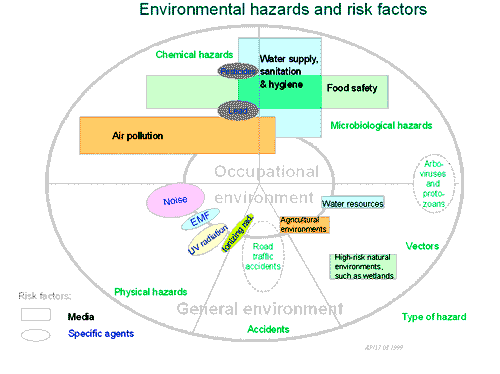 | International Report Outlines Hazards Faced by Children |
 | International Report Outlines Hazards Faced by Children |
|
By Ellen Kuwana Neuroscience for Kids Staff Writer May 14, 2002
The report focused in part on adolescents, a young group where chronic diseases and the wear and tear of everyday living are not yet evident. Indeed, most adolescents (90% in 23 countries) reported feeling healthy. This age group, however, had more severe outcomes from health problems than younger children. In this age group, for example, depression often leads to suicide. The WHO states that 70% of premature (preventable) adult deaths arise from behaviors, especially drug abuse, that began in the teen years. Every year, drug abuse, complications from pregnancy and childbirth, suicides and injuries contribute to approximately 1.5 million deaths in the adolescent population. |
 Image courtesy of the World Health Organization |
 The survey also examined tobacco and alcohol use in
11-, 13- and 15-year-old students. In general, more boys than girls have
tried cigarettes. The exceptions to these data are children in Canada, the
Russian Federation, Latvia and Estonia. By the age of 11, 20% of students
worldwide have tried tobacco. By the age of 13, that number has increased
to 40-50%; at 15 years of age, 60-70% of students have tried cigarettes.
As children get older, they also tend to smoke more cigarettes: at 11,
students smoke 1-2 cigarettes per week; at 13, they smoke up to 5; at 15,
students smoke 8-30 cigarettes per week. The survey also examined tobacco and alcohol use in
11-, 13- and 15-year-old students. In general, more boys than girls have
tried cigarettes. The exceptions to these data are children in Canada, the
Russian Federation, Latvia and Estonia. By the age of 11, 20% of students
worldwide have tried tobacco. By the age of 13, that number has increased
to 40-50%; at 15 years of age, 60-70% of students have tried cigarettes.
As children get older, they also tend to smoke more cigarettes: at 11,
students smoke 1-2 cigarettes per week; at 13, they smoke up to 5; at 15,
students smoke 8-30 cigarettes per week.
The numbers speak for themselves and are particularly alarming when examined for children under the age of five. Young children are not simply small adults. Children are still developing and thus are more vulnerable to toxins, which may cause irreversible harm to their developing organs. Children live closer to the ground, put things in their mouths without regard for safety, breathe faster, eat more and drink more than adults for their body size. These factors all contribute to the absorption of toxins by children. In developing countries, it is estimated that 3 million children under the age of five die each year from environmental hazards such as unsanitary drinking water and exposure to chemicals such as pesticides, arsenic, lead and other pollutants. |
| Did You Know?
|
|
| References:
|
| GO TO: | Neuroscience In The News | Explore the Nervous System | Table of Contents |
![[email]](./gif/menue.gif) Send E-mail |
 Fill out survey |
 Get Newsletter |
 Search Pages |
 Take Notes |